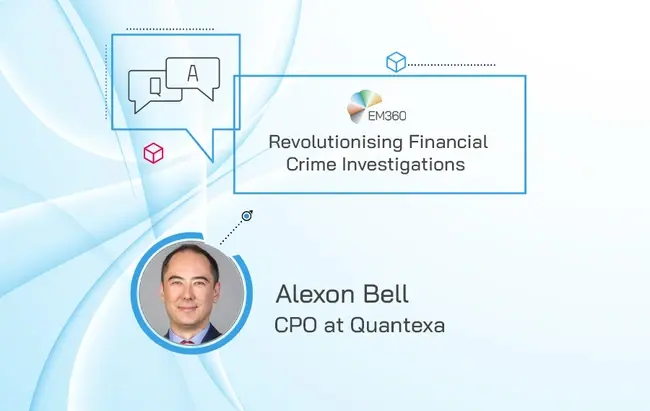UK bank fraud has hit a record high. According to UK Finance, consumers lost £479 million to financial fraud and crime in 2020, with the pandemic triggering a cyber fraud epidemic as scammers have been using social engineering to ‘prey on people’s fears and uncertainties about [COVID-19] to defraud them.’ Covid-loan fraud and error are also costing UK taxpayers tens of billions of pounds alone as basic fraud checks were dropped in haste. This staggering rise in crime is, therefore, of no surprise, especially since investigators have been struggling with unmanageable amounts of data, false positives, and legacy AI models that fail to detect risk. So, what’s the solution?

Quantexa, the data and analytics software company pioneering contextual decision intelligence (CDI), believes the answer lies in combining human and machine intelligence, in which they launched a new contextual decision intelligence (CDI) solution to demonstrate its power. Joining us to tell us more is Alexon Bell, Chief Product Officer at Quantexa. Alexon has worked in the risk and fraud industry for over 20 years, specialising in anti-money laundering (AML) regulation and compliance.
Welcome to EM360 Alexon! Can you start by giving us an insight into your motivations behind investigating and fighting financial fraud?
Ever since my time at university, I’ve had a keen interest in business, finance and AML. It has now been over 20 years since I started my journey to help global organizations meet their AML regulation requirements. This came from the rise of trade-based money laundering and its difficulty in prevention. There is a serious lack of expertise and weakness in the legacy systems currently used to deal with this form of extreme financial crime. This is what motivated me and the development specifically of Quantexa’s Contextual Decision Intelligence platform to tackle AML and financial crime, as well as other data management-related risks and opportunities enterprises find.
From your qualification from the Association of Certified Anti-Money Laundering Specialists to your on-the-job experience, you have extensive expertise in AML. How has fraud management changed since you first started working in the field and what role has technology played in enhancing it?
Some aspects of fraud have changed, some have remained the same – and others have yet to be solved as those challenges are around the siloed nature of controls. Criminals are not just abusing the banks on a single channel or product - credit cards, cheques, online - but across all channels at all times. Fraud manifests in many ways; think loan applications, phishing, spear phishing, mules, etc, but technology is not only helping the banks, it’s helping the criminals, too. The rapid rise of cryptocurrency in ransomware is a great example of technology helping criminals. Whereas Artificial Intelligence (AI), Machine Learning (ML), Entity Resolution (ER) and Network Analytics are great examples of where technology is helping the banks.
Fraud, like AML, is perpetrated by a small group of individuals and it takes a network-based analytical approach to uncover that network of criminals. The ability to use Entity Resolution combined with Network Generation to break information and system siloes in order to create a holistic view of financial crime is paying dividends. The appreciation that Fraud and AML are linked - as all proceeds of crime have to be laundered - means that the holistic view should encompass both worlds, and this broader view coupled with more advanced analytics allows banks to react quicker, while also identifying emerging trends faster.
As a result of the better application of technology and AI-enhanced models that speed up investigation processes, fraud management has inherently changed. Nevertheless, as we have seen from the pandemic - what we thought was a modern AI approach failure to uncover the fraud or detect the laundering, primarily as these systems looked to understand and profile normal activity - everything changed and there was no “normal”. These platforms went haywire, producing may false positives as everyone was behaving abnormally and the criminals hid in plain sight.
However, as technology becomes smarter, so do the fraudsters. This means investigators are constantly struggling to catch crime in real-time, which means technology must continue to adapt to match pace. This is what Quantexa’s Contextual Decision Intelligence platform seeks to achieve. With it, enterprises can reduce the number of false positives received in legacy fraud management processes by up to 95%, and illicit activity can be spotted and stopped.
Quantexa’s Syneo solution is marketed as ‘The new standard in financial crime and fraud risk detection’; it aims to ‘revolutionise’ monitoring and investigations across the enterprise. How exactly does the solution work and why is it considered such a big move for the industry?
The Syneo solution itself is an all-in-one solution for both the monitoring as well as the investigation of financial fraud and crime.
Syneo starts by connecting internal and external data together across different products, countries, transactions, data platforms, and control systems using Entity Resolution. It highlights the connections hidden and disclosed between customers, counter parties, business, geographies and so on.
For financial crime investigation teams, this automates time-intensive manual data gathering analysis, which consequently empowers investigators with intuitive visualization tools for better exploration and decision-making. Overall, this improves enterprise-wide risk detection as it creates a holistic view, critical in combating organized crime and professional money laundering.
When this approach is applied to detection it is game-changing as the Syneo approach create more features or inputs to the detection models which provides significant uplift (30%+) to the models and also delivers the ability to find collusive risk at a network level.
What are the core business benefits of using this machine intelligence-based tool?
There are several benefits to using the Quantexa platform for fraud and financial crime investigations. Firstly, it finds new risks that traditional legacy approaches have missed (both AML and Fraud). This results in a significant reduction – up to 75% - of false positives.
As well as this, the platform is 80% more efficient, speeding up investigations by augmenting the human decision-making process. It can also be re-used to solve multiple problems as well as financial crime detection and investigation, including credit risk, customer 360, marketing and Know Your Customer (KYC).
Due to the platform’s alignment with FSIs’ big data strategy, Quantexa’s no data model approach and dynamic Entity Resolution allows us to sit on the data lake and choose the data sources for resolution at the time of request, allowing multiple use cases to be solved with one platform and removing multiple copies of the data. In this way, the platform drives consistency, by using scoring to encode the bank's process to automate an L1 review in software.
Contextual decision intelligence/contextual monitoring are integral to Syneo. What do these terms mean and how does this framework compare to transaction monitoring, or what you recently described as ‘the old world of traditional monitoring’?
The Quantexa approach incorporates all of the features of traditional transaction monitoring (TM) (old world) but more importantly focuses on the originators and beneficiaries of transactions (Customer’s customer or counter parties), and what and who they connect to through directorships, shareholders, UBOs, and the like. It has been proven to be very successful at identifying shell companies, links to corrupt politicians, sanctions risk and known fraud rings and syndicates.
At the core of the Quantexa solution is Entity Resolution and Network Generation. Coupled with open-source AI and machine learning, Quantexa can be deployed within existing solution ecosystems to optimise traditional TM system alerting; manage more effective Investigations (Complex and Operational alerts); provide supplementary Alerting (Human Trafficking, CTF, CEM, Mules, etc), and perform complex Alerting (Correspondent Banking, Markets AML, Trade-Based Money Laundering).
What are your hopes for the future of financial fraud and crime detection and response?
Fincrime tech is in a very exciting place. There is a wholesale change in the approach of the control systems and an appreciation in the market that Data is the key to solving the problem. If enterprises can fix the data, AI and ML become hyper-effective.
As technology progresses, we can begin to outsmart fraudsters and money launders without them catching up. If enterprises start shifting from legacy transactional monitoring systems, they will be able to prevent money laundering and further financial crime as well as using this same approach to help spot opportunities - such as upselling and cross-selling - that they might not have seen before. I’m also hopeful that more companies will start to realise the importance of gaining a more holistic view of AML and Fraud, which will inevitably lead to better prevention mechanisms and outcomes.
The reality is that AML and Fraud is rising up on the agenda of governmental agencies, which means that industry must respond. The European Union is launching a new unit to focus on raising the level of compliance across the union as we have seen organizations and countries are only as strong as their weakest link.
Hopefully, this is the start of public/private partnerships, where the sharing of data between bodies becomes part of policy. If data starts getting shared between government, law enforcement and banks, as well as bank to bank, this holistic overview of AML and Fraud will come to light and be able to stop criminals in their tracks far more effectively.







Comments ( 0 )